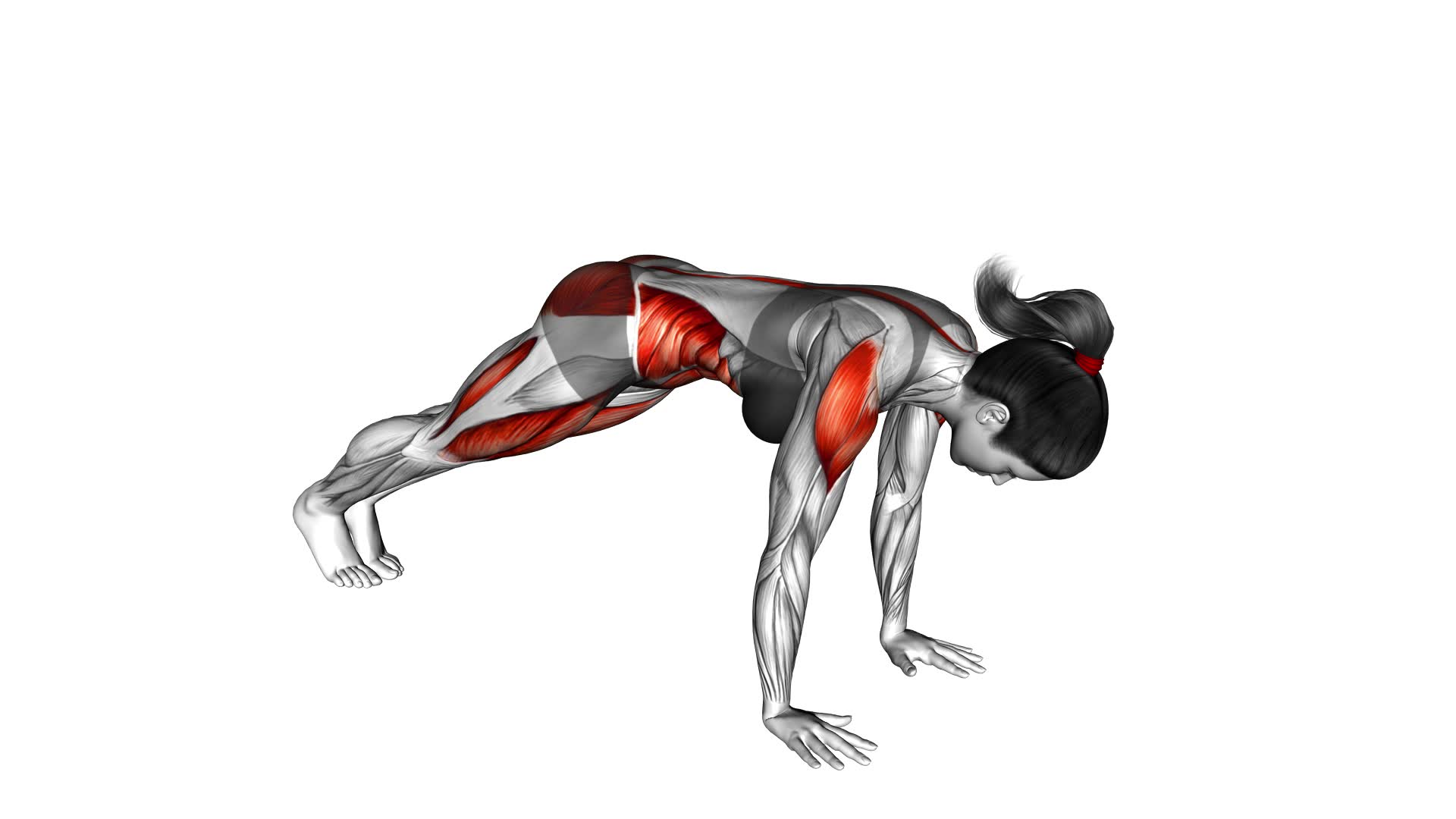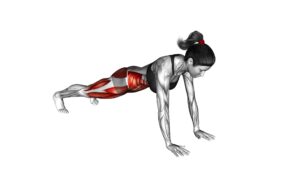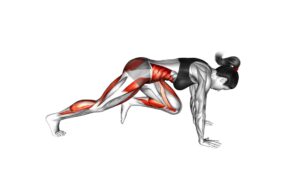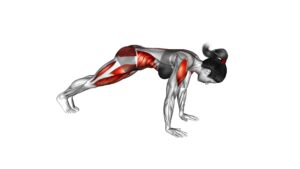Mountain Climber (female) – Video Exercise Guide & Tips

Are you looking for a challenging and effective exercise? Look no further than mountain climbers!
Watch This Exercise Video
This video exercise guide and tips article is specifically designed for female mountain climbers like you.
Learn the proper form and technique, discover modifications for beginners and advanced users, and find out how to incorporate mountain climbers into your workout routine.
Avoid common mistakes and maximize the effectiveness of your workouts with these expert tips.
Get ready to conquer the mountains!
Key Takeaways
- Mountain climbers engage multiple muscle groups
- Proper form and technique are important for reducing the risk of injury
- Core engagement is crucial for stability and targeting abdominal muscles effectively
- Maintaining proper alignment throughout the exercise optimizes benefits and reduces the risk of injury
Benefits of Mountain Climbers for Women
Mountain climbers are an effective exercise for women because they engage multiple muscle groups and provide a high-intensity cardiovascular workout. These exercises are a great addition to any fitness routine due to their numerous benefits.
Firstly, mountain climbers target the core muscles, including the abdominals, obliques, and lower back. By engaging these muscles, mountain climbers can help women develop a strong and toned core, improving stability and posture.
Additionally, this exercise also works the upper body, specifically the shoulders, chest, and arms. Regular practice of mountain climbers can lead to increased upper body strength and definition.
Moreover, mountain climbers are an excellent cardiovascular exercise that gets your heart rate up and burns calories. They can be performed at a fast pace, making them an efficient way to improve cardiovascular fitness and burn fat.
Lastly, mountain climbers are a versatile exercise that can be modified to suit different fitness levels and goals. Whether you're a beginner or an experienced athlete, mountain climbers can be adjusted to challenge you and help you progress.
Proper Form and Technique for Mountain Climbers
To perform mountain climbers with proper form and technique, it's important to engage your core throughout the exercise. This will help stabilize your body and prevent any unnecessary strain on your lower back.
Additionally, make sure to maintain proper alignment by keeping your hips in line with your shoulders, and your wrists directly under your shoulders.
Core Engagement Importance
Ensure proper core engagement during your mountain climbers for maximum effectiveness and safety. Core stability and core strength are crucial for performing mountain climbers correctly.
When you engage your core muscles, you create a stable base from which to move your legs and arms. This stability helps to maintain proper alignment and form throughout the exercise, reducing the risk of injury. By actively engaging your core, you also increase the intensity of the workout and target your abdominal muscles more effectively.
To engage your core during mountain climbers, focus on pulling your belly button towards your spine, tightening your abdominal muscles, and maintaining a strong and stable torso throughout the movement.
Proper Alignment Tips
To maintain proper alignment and technique during mountain climbers, it's important to consistently engage your core muscles. Alignment awareness is crucial to prevent injury and maximize the effectiveness of this exercise.
One common misconception is that mountain climbers should be performed with a rounded back. However, this can strain your lower back and lead to discomfort. Instead, focus on keeping your spine neutral, with your head, neck, and back aligned.
Another key aspect is to avoid sagging hips or lifting them too high, as this can put unnecessary pressure on your shoulders and lower back. By maintaining proper alignment and form, you'll optimize the benefits of mountain climbers and reduce the risk of injury.
Now, let's discuss breathing techniques for endurance.
Breathing Techniques for Endurance
Breathe deeply and rhythmically to maintain endurance and optimize your performance during mountain climbers. Proper breathing techniques are crucial for endurance training and can greatly enhance your overall performance.
When performing mountain climbers, it's important to focus on your breath and synchronize it with your movements. Start by inhaling deeply through your nose as you bring your knee towards your chest, and exhale forcefully as you extend your leg back. This deep inhale and forceful exhale will help you engage your core muscles and maintain stability throughout the exercise.
Practice controlled breathing exercises outside of your workouts to improve your lung capacity and endurance. Remember, mastering proper breathing techniques is key to maximizing your endurance and getting the most out of your mountain climber workouts.
Modifications for Beginners and Advanced Users
Modify the mountain climber exercise to suit your fitness level, whether you're a beginner or an advanced user. Here are some modifications you can make:
- Beginner modifications:
- Start with a slower pace: If you're new to mountain climbers, begin by performing them at a slower pace. This will allow you to focus on your form and build up your strength gradually.
- Modify the range of motion: If you find it challenging to bring your knees all the way to your chest, you can modify the exercise by bringing your knees towards your elbows instead. This variation still engages your core and helps you build endurance.
- Advanced modifications:
- Increase the speed: Once you have mastered the basic mountain climber exercise, you can challenge yourself by increasing the speed. This will elevate your heart rate and provide an intense cardio workout.
- Add a twist: To further engage your obliques, you can incorporate a twist into the mountain climber exercise. As you bring your knee towards your chest, rotate your hips to the side and touch your knee with the opposite elbow. Alternate sides with each rep.
Remember to always listen to your body and modify the exercise as needed. It's important to find the right balance between challenging yourself and maintaining proper form to avoid injury.
Incorporating Mountain Climbers Into Your Workout Routine
Incorporating mountain climbers into your workout routine can provide numerous benefits.
Not only do they help to increase cardiovascular endurance, but they also work multiple muscle groups, including your core, arms, and legs.
Whether you're a beginner or advanced user, there are variations available to suit your fitness level, and focusing on proper form can help you maximize the effectiveness of the exercise.
Benefits of Mountain Climbers
You can easily incorporate mountain climbers into your workout routine to reap the numerous benefits they offer. Here are some reasons why you should consider adding mountain climbers to your exercise regimen:
- Pros of Mountain Climbers:
- They provide a full-body workout, engaging multiple muscle groups simultaneously.
- Mountain climbers are a great cardio exercise, helping to improve your cardiovascular endurance.
- Cons of Mountain Climbers:
- They can be challenging for beginners or those with wrist or shoulder issues.
- Performing mountain climbers with incorrect form can lead to injury.
Alternative exercises to mountain climbers include plank jacks, high knees, or burpees. These exercises offer similar benefits while providing variation to your routine.
Variations for All Levels
To further enhance your workout routine and continue reaping the benefits of mountain climbers, let's explore different variations suitable for all fitness levels.
If you're a beginner, you can start by performing mountain climbers at a slower pace or by placing your hands on an elevated surface, such as a step or bench, to reduce the intensity.
As you progress, you can increase the speed and intensity of your mountain climbers, incorporating jumps or adding a resistance band around your ankles for a more challenging workout.
Advanced modifications include performing mountain climbers with sliders, which require more core stability, or incorporating a push-up between each leg movement.
These variations will help you continually challenge your body and improve your overall fitness level.
Now, let's move on to the next section and learn how to improve your form during mountain climbers.
How to Improve Form
To improve your form while incorporating mountain climbers into your workout routine, focus on maintaining a strong core and engaging your upper body muscles. Here are some tips to help you maximize your performance and reduce the risk of common injuries:
- Keep your hands directly under your shoulders to ensure proper alignment.
- Engage your core by pulling your belly button towards your spine throughout the exercise.
- Avoid rounding your back and keep it straight to prevent strain on your lower back.
- Maintain a steady pace and gradually increase your speed to improve cardiovascular endurance.
- Land softly on the balls of your feet to minimize impact on your joints.
By following these tips, you can improve your form, increase your speed, and reduce the risk of common injuries.
Now let's explore the common mistakes to avoid while doing mountain climbers.
Common Mistakes to Avoid While Doing Mountain Climbers
Avoiding these common mistakes will help you perform mountain climbers with proper form and maximize the effectiveness of this exercise.
One of the most common mistakes people make while doing mountain climbers is letting their hips sag. This not only puts unnecessary strain on your lower back but also takes away from the core engagement that this exercise is meant to target. To avoid this, make sure to keep your core tight and your hips in line with your shoulders throughout the movement.
Another mistake is rushing through the exercise. Mountain climbers should be done with control and precision. Take your time and focus on maintaining proper form rather than trying to speed through the reps.
Lastly, avoid lifting your hips too high or too low. Lifting your hips too high will place more emphasis on your shoulders rather than your core, while lifting them too low will reduce the effectiveness of the exercise. Instead, aim for a straight line from your head to your heels.
By avoiding these common mistakes, you'll be able to perform mountain climbers correctly and get the most out of this challenging exercise.
Now, let's move on to some tips for maximizing the effectiveness of mountain climbers.
Tips for Maximizing the Effectiveness of Mountain Climbers
To maximize the effectiveness of your mountain climbers, focus on maintaining proper form and engaging your core throughout the exercise. This won't only help you maximize calorie burn but also prevent injuries.
Here are some tips to help you get the most out of your mountain climbers:
- Keep your hands directly under your shoulders and your body in a straight line from head to toe.
- Engage your core by drawing your belly button towards your spine and bracing your abs. This will help stabilize your body and prevent your lower back from sagging. It will also increase the intensity of the exercise and maximize calorie burn.
- Maintain a steady pace and avoid rushing through the movement.
- Breathe deeply and exhale forcefully as you bring your knees towards your chest. This will engage your core even more and help you maintain control throughout the exercise.
- If you're a beginner, start with shorter intervals and gradually increase the duration as you build strength and endurance.
- Listen to your body and modify the exercise if needed to prevent any discomfort or pain.
Frequently Asked Questions
What Are the Different Variations of Mountain Climbers That Can Be Done?
There are several different variations of mountain climbers that you can do to work your whole body. These variations include the standard mountain climber, the cross-body mountain climber, and the spider mountain climber. Each variation targets different muscle groups and adds variety to your workout routine.
Mountain climbers are great for overall body strength because they engage your core, arms, and legs all at once. Adding them to your exercise routine can help you build strength and improve your endurance.
Can Mountain Climbers Help in Toning the Abdominal Muscles?
Mountain climbers are a great exercise for toning your abdominal muscles. They also provide benefits for overall body strength.
To modify mountain climbers for beginners, you can start by performing them at a slower pace and with shorter intervals. As you become more advanced, you can increase the speed and duration of the exercise.
Remember to engage your core and maintain proper form throughout.
Keep up the hard work and you'll see results!
Are There Any Specific Breathing Techniques to Follow While Performing Mountain Climbers?
When performing mountain climbers, it's important to focus on your breathing technique. By inhaling deeply through your nose and exhaling forcefully through your mouth, you can maximize the oxygen intake and release any tension in your muscles.
This will help you maintain proper form and enhance the effectiveness of the exercise. Incorporating proper breathing techniques into your mountain climbers will ensure a more efficient workout and improve your overall fitness.
How Can Mountain Climbers Help in Improving Cardiovascular Fitness?
Mountain climbers are an excellent exercise for improving cardiovascular fitness. By engaging multiple muscle groups and increasing heart rate, they help to build endurance and strengthen the heart.
Incorporating mountain climbers into a HIIT workout can further enhance their benefits, as the high-intensity intervals challenge the cardiovascular system even more.
Including mountain climbers in a full body workout provides a comprehensive workout that targets the upper body, lower body, and core, making it an efficient and effective way to improve overall fitness.
Are There Any Specific Warm-Up Exercises Recommended Before Doing Mountain Climbers?
Before doing mountain climbers, it's important to warm up with some preparatory exercises. These exercises can help activate your muscles and get your body ready for the intensity of mountain climbers.
Warming up can also help prevent injuries and improve your performance during the exercise. By incorporating warm-up exercises into your routine, you can maximize the benefits of mountain climbers and ensure a safe and effective workout.
Conclusion
In conclusion, mountain climbers are a highly effective exercise for women that offer numerous benefits.
By maintaining proper form and technique, beginners and advanced users alike can engage in this versatile workout. Incorporating mountain climbers into your routine can help improve cardiovascular endurance, strengthen core muscles, and burn calories.
However, it's important to avoid common mistakes and follow these tips to maximize the effectiveness of mountain climbers.
So, why not give this challenging yet rewarding exercise a try and elevate your fitness journey?

Author
Years ago, the spark of my life’s passion ignited in my mind the moment I stepped into the local gym for the first time. The inaugural bead of perspiration, the initial endeavor, the very first surge of endorphins, and a sense of pride that washed over me post-workout marked the beginning of my deep-seated interest in strength sports, fitness, and sports nutrition. This very curiosity blossomed rapidly into a profound fascination, propelling me to earn a Master’s degree in Physical Education from the Academy of Physical Education in Krakow, followed by a Sports Manager diploma from the Jagiellonian University. My journey of growth led me to gain more specialized qualifications, such as being a certified personal trainer with a focus on sports dietetics, a lifeguard, and an instructor for wellness and corrective gymnastics. Theoretical knowledge paired seamlessly with practical experience, reinforcing my belief that the transformation of individuals under my guidance was also a reflection of my personal growth. This belief holds true even today. Each day, I strive to push the boundaries and explore new realms. These realms gently elevate me to greater heights. The unique combination of passion for my field and the continuous quest for growth fuels my drive to break new ground.







